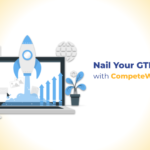
Choosing the Right Product Marketing KPIs to Measure Success for B2B SaaS
- Milind Soni
- September 10, 2024
- Blog
- #b2b, #competewiser, #gotomarketstrategy, #gtmstrategy, #productmarketing
- 0 Comments
Before launching your product marketing, governed by your go-to-market strategy how do you ensure if your efforts will pay off? The key lies in selecting the right Key Performance Indicators (KPIs) beforehand to measure success the moment you push the ignition button of your product marketing machinery.
Understanding which metrics to track is crucial for fine-tuning your approach. This blog will walk you through how KPIs like Customer Acquisition Cost (CAC), Lifetime Value (LTV), and Monthly Recurring Revenue (MRR) can be used to assess the effectiveness of your product marketing efforts. You will discover how they fit into your GTM strategy, and how leveraging competitive analysis tools like CompeteWiser can give you the edge to outsmart your competitors.
Why Product Marketing KPIs Matter for B2B SaaS
The right KPIs offer clear insights into your marketing and sales performance, helping you make data-driven decisions that align with your business goals. In the B2B SaaS landscape, where recurring revenue and long-term customer relationships are vital, tracking key metrics allows you to:
- Optimize your go-to-market strategy.
- Improve customer engagement and satisfaction.
- Measure product-market fit and adjust targeting accordingly.
Essential Product Marketing KPIs for B2B SaaS
1. Customer Acquisition Cost (CAC)
CAC is a crucial metric that tracks how much it costs to acquire a new customer. For B2B SaaS companies, where the sales cycle is often long and requires substantial resources, keeping this cost in check is vital for profitability.
Why it matters: A high CAC can eat into your profits. Optimizing this KPI ensures that you’re acquiring customers efficiently.
How CompeteWiser Helps: CompeteWiser can show you how your competitors are allocating their marketing budgets, allowing you to optimize your spending and reduce CAC.
2. Lifetime Value (LTV)
LTV represents the total revenue a customer brings over their entire relationship with your company. It’s a key measure of success in B2B SaaS where retention and long-term relationships matter more than one-time purchases.
Why it matters: A higher LTV allows you to justify a higher CAC. It’s a critical factor in understanding customer value and profitability.
How CompeteWiser Helps: By benchmarking your competitors’ retention strategies, CompeteWiser can help you enhance customer loyalty and grow your LTV.
3. Monthly Recurring Revenue (MRR)
MRR is the backbone of any B2B SaaS business, reflecting the predictable revenue you can expect each month from active subscriptions. Tracking MRR helps you understand how well you’re converting leads into paying customers and retaining them over time.
Why it matters: Consistent MRR growth shows that your product and marketing strategies are working.
4. Churn Rate
Churn rate measures the percentage of customers who stop using your service. A high churn rate can indicate product dissatisfaction or poor customer retention efforts, which is critical to address in B2B SaaS.
Why it matters: Reducing churn means you’re retaining customers, increasing LTV, and improving overall profitability.
How CompeteWiser Helps: Analyze your competitors’ churn rates with CompeteWiser to identify gaps and fine-tune your retention strategies.
5. Conversion Rate
Tracking the conversion rate at each stage of your sales funnel provides insight into the effectiveness of your go-to-market strategy. Conversion rates highlight how well your marketing efforts are turning leads into paying customers.
Why it matters: A low conversion rate signals inefficiencies in your sales funnel, while a high conversion rate indicates your message and offer are resonating with your target market.
Go-to-Market Strategy and KPIs
Your go-to-market strategy (GTM) directly influences the KPIs you should focus on. A well-executed GTM strategy involves identifying your target audience, positioning your product effectively, and using the best channels to engage your prospects. To measure how well your GTM strategy is working, you need to track key performance metrics that reflect your success in penetrating your target market and competing effectively.
1. Measuring Target Market Penetration
To succeed, you need to measure how well you’re penetrating your target market. KPIs like market share growth, CACand customer retention rate help gauge the effectiveness of your strategy.
Why it matters: If your KPIs show low penetration, it may indicate that your positioning or targeting needs adjustment.
Essential Target Market Penetration KPIs
These KPIs measure how well your product is resonating with and capturing your target audience.
a. Market Share Growth
- What it measures: The percentage of your industry’s market that your company controls.
- Why it matters: This KPI directly shows how well you’re penetrating your target market compared to competitors.
b. Customer Acquisition Cost (CAC)
- What it measures: The total cost of acquiring a new customer, including marketing and sales expenses.
- Why it matters: Monitoring CAC ensures that your go-to-market strategy is efficient. A high CAC could indicate poor targeting or inefficient marketing channels.
c. Customer Retention Rate
- What it measures: The percentage of customers who continue to use your product over a given period.
- Why it matters: A high retention rate suggests that your product is well-aligned with customer needs and the right market fit.
2. Monitoring Competitor Performance
Competitive analysis is crucial when defining and refining your go-to-market approach. Tools like CompeteWiser provide real-time insights into your competitors’ target market analysis and performance, helping you adjust your strategies for better results.
Why it matters: Knowing how your competitors are performing allows you to refine your market strategy and stand out. This insight can reveal untapped opportunities or areas where your competitors fall short, helping you position your product more effectively.
Essential Competitor Performance Monitoring KPIs
These KPIs assess your position in the market relative to your competitors.
a. Competitive Win Rate
- What it measures: The percentage of deals you win when competing against a direct competitor.
- Why it matters: A high win rate shows that your product and messaging outperform competitors in the market.
b. Time to Market
- What it measures: The time it takes for your product to be available to the market after development begins.
- Why it matters: Faster time to market can give you a competitive edge, allowing you to capture more market share before competitors catch up.
c. Feature Adoption Rate
- What it measures: The rate at which users adopt new features compared to similar products from competitors.
- Why it matters: Tracking feature adoption shows how well your product differentiates itself in the market and whether your new features offer more value than competitors.
d. Pricing Competitiveness
- What it measures: A comparison of your pricing model versus competitors, adjusted for feature set and perceived value.
- Why it matters: If your pricing is more competitive without sacrificing quality or features, you have an advantage in acquiring customers in your target market.
e. Share of Voice
- What it measures: The percentage of industry-related mentions your brand receives online compared to competitors.
- Why it matters: A higher share of voice can indicate better brand visibility and more effective marketing efforts in your go-to-market strategy.
Using Competitive Analysis for Target Market Insights
Understanding your competitors’ strategies and their success with target markets is crucial for refining your own B2B SaaS strategy. With CompeteWiser, you can:
- Identify the segments your competitors are targeting.
- Compare their KPIs like CAC, LTV, and churn rate to optimize your own performance.
- Benchmark your go-to-market strategy against industry leaders to ensure you’re on the right track.
Choosing the Right KPIs for Your B2B SaaS Business
When selecting KPIs, make sure they align with your business objectives and go-to-market strategy. Here’s how to choose the right ones:
- Focus on Actionable Metrics: Select KPIs that directly impact your business. MRR, CAC, and churn rate are often the most actionable for B2B SaaS companies.
- Align KPIs with Your Goals: If customer retention is your priority, focus on metrics like LTV and churn rate. For growth, prioritize CAC and conversion rate.
- Leverage Competitive Insights: Use tools like CompeteWiser to benchmark your KPIs against your competitors and adjust your strategy accordingly.
Conclusion
Tracking the right product marketing KPIs is essential for driving success in B2B SaaS. Metrics like CAC, LTV, MRR, and churn rate provide critical insights into how well your go-to-market strategy is performing. By leveraging competitive analysis through tools like CompeteWiser, you can refine your strategy, better understand your target market, and stay ahead of the competition.




